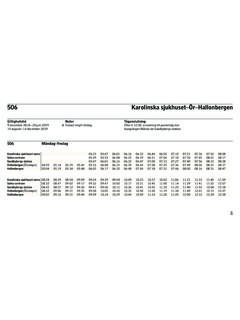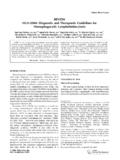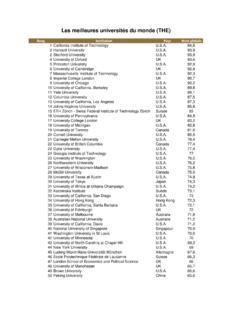Transcription of SUN PROTECTION - WHO
1 SUN PROTECTIONA Primary Teaching ResourceWORLD HEALTH ORGANIZATION2003A Primary Teaching ResourceWORLD HEALTH ORGANIZATIO2003 World Health Organization 2003 All rights reserved. Publications of the World Health Organization can be obtained from Marketing andDissemination, World Health Organization, 20 Avenue Appia, 1211 Geneva 27, Switzerland (tel: +41 22 7912476; fax: +41 22 791 4857; email: Requests for permission to reproduce or translateWHO publications whether for sale or for noncommercial distribution should be addressed toPublications, at the above address (fax: +41 22 791 4806; email: designations employed and the presentation of the material in this publication do not imply theexpression of any opinion whatsoever on the part of the World Health Organization concerning the legalstatus of any country, territory, city or area or of its authorities, or concerning the delimitation of its frontiersor boundaries.))
2 Dotted lines on maps represent approximate border lines for which there may not yet be mention of specific companies or of certain manufacturers products does not imply that they areendorsed or recommended by the World Health Organization in preference to others of a similar nature thatare not mentioned. Errors and omissions excepted, the names of proprietary products are distinguishedby initial capital World Health Organization does not warrant that the information contained in this publication iscomplete and correct and shall not be liable for any damages incurred as a result of its by Con Stamatis, The Cancer Council VictoriaPrinted in FranceAvailable at Library Cataloguing-in-Publication DataSun PROTECTION in schools: an educational package to protect children fromultraviolet : Sun PROTECTION and schools: how to make a difference -- Sunprotection: a primary teaching resource -- Evaluating school programmes topromote sun Sunlight - adverse effects 2.
3 Ultraviolet rays - adverse effects 3. Radiationinjuries - prevention and control 4. Radiation PROTECTION - methods 5. Schoolhealth services - organization and administration 6. Teaching 92 4 159062 9(NLM classification: WA 350)iiPreface .. ivA Comprehensive Approach to Sun PROTECTION .. 1 Teaching Strategies .. 2 Interdisciplinary Approaches .. 3 Background Information .. 5 Unit 1: The sun and UV radiation .. 5 Unit 2: Health risks of UV radiation exposure .. 8 Unit 3: Sun safety through sun PROTECTION .. 11 Teaching Activities .. 13 Early primary teaching activities .. 13 Late primary teaching activities .. 18 Further Information .. 25 Glossary .. 27 Annex: Worksheets .. 29 CONTENTS iiiivChildren are more sensitive to ultraviolet (UV)radiation damage than adults, and sunburn duringchildhood increases the risk of skin cancer and eyedamage (particularly cataracts) later in life, andsuppresses the immune the first 18 years of life, when much of thelifetime UV radiation exposure is received, a significantproportion of time is spent at school or participatingin school-based activities, such as camps or schoolsports.
4 School children are also especially susceptibleto fashion trends, suggesting that a suntan is healthy,and skills-based health education can help them toresist peer is important to target children s attitudes andbehaviour at a young age, particularly at primaryschool, when children tend to be most receptive tothe need for sun PROTECTION . Individuals who developsuch life skills at a young age are more likely to adoptand sustain a healthy lifestyle during schooling andfor the rest of their worldwide participated in theInternational Workshop on Children s Sun ProtectionEducation,organized by the World HealthOrganization (WHO), held in Orvieto, Italy, on 4 October on the outcomes of this workshop, WHOhas developed a comprehensive package of materialsfor children s sun PROTECTION includes: Sun PROTECTION and Schools: How to Make aDifference, which describes the importance ofsun PROTECTION in schools, and outlinesnecessary steps for establishing a schoolprogramme.
5 Sun PROTECTION : A Primary Teaching Resource,which is for primary school teachers andprovides suggestions and ready-made teachingactivities. Evaluating School Programmes to Promote SunProtection, which is for schools, and educationaland health teaching resource, prepared by Eva Rehfuess,WHO, aims to provide primary school teachers with astarting point to incorporate sun PROTECTION into thecurriculum and school activities. Realizing the generalshortage of time and financial resources, thesuggested materials and activities are intended tohelp teachers address sun PROTECTION without muchextra time or preparation. The resource draws heavilyon the experience of the SunSmart Campaign schoolsprogramme in Australia, and the SunWise schoolprogramme in the United can Sun PROTECTION : A Primary TeachingResourcebe used?
6 This resource offers ideas and materials to make it aseasy as possible for teachers to integrate sunprotection into their classroom activities. It describesa comprehensive approach to sun PROTECTION ,provides background information on UV radiation andsun PROTECTION , and suggests a variety of teachingstrategies and interdisciplinary approaches. It isintended to provide guidance, rather than materials and lesson plans from existingprogrammes were selected and grouped for twodifferent age groups early primary school (ages 6 9)and late primary school (ages 10 12) although theseage groupings will vary slightly from country can put the ready-made lesson plansdirectly into action. However, they may also refer tothese as a list of ideas for the development of theirown lesson information, teaching resources, andactivities can be obtained from the list of sunprotection school programmes and interactivewebsites for children in the section titled Furtherinformation.
7 AcknowledgmentWHO would like to thank the following individualswho offered substantial comments and suggestionsduring the International Workshop on Children s SunProtection Education and during the document sfinalization:Anat Aizik, Israeli Cancer Association, IsraelCecilia Boldeman, Karolinska Hospital, SwedenPi rre C sarini, S curit Solaire, FranceAngus Fergusson, Meteorological Service ofCanada, CanadaRobin Fuchs-Young, University of Texas, UnitedStatesBeat Gerber, Swiss Federal Office of Public Health,SwitzerlandSandra Gordon, Eastern Health and Social ServicesBoard, Northern IrelandStephanie Harper, The Cancer Council Victoria,AustraliaGianni Mariutti, Istituto Superiore di Sanit , ItalyJill Meara, National Radiological PROTECTION Board,United KingdomIrena Miseviciene, Kaunas University of Medicine,LithuaniaUlrik Ringborg, Karolinska Hospital, SwedenMike Repacholi, World Health Organization,SwitzerlandColin Roy.
8 Australian Radiation PROTECTION andNuclear Safety Agency, AustraliaMiguel Angel Santinelli-Ramos, Institute ofSecurity and Social Services for the State Workers,MexicoMona Saraiya, Centers for Disease Control, UnitedStatesCraig Sinclair, The Cancer Council Victoria, AustraliaTerry Slevin, Cancer Foundation of WesternAustralia, AustraliaSkaidra Valiukeviciene, Kaunas University ofMedicine, Lithuania1A COMPREHENSIVEAPPROACH TO SUNPROTECTIONA dopting an integrated approach to help students,teachers, staff, and the wider community to avoidhealth risks of ultraviolet (UV) radiation exposure canmake a school programme on sun PROTECTION veryeffective. Important elements include sun protectioneducation, a healthy school environment, andcommunity and family involvement.
9 Not all schoolswill have the resources to integrate sun protectioninto all of these components. It is more important tostart with small, feasible changes than to wait untilresources become available to address allcomponents health educationSkills-based health education helps individuals todevelop knowledge, attitudes, values, and life skillsthat are needed to make positive health-relateddecisions, and to put these into daily , sun PROTECTION education must be culturallyand geographically relevant. It can be made practicalby developing the immediate connection with thestructural and social environment children live supportive environmentWhile it is a personal decision to adopt sensible sunbehaviour, positive choices can be supported throughadequate structural and policy measures.
10 Theavailability of shade structures at schools and day carecentres is likely to reduce children s UV radiation dosesignificantly. A sun PROTECTION policy expresses aschool s commitment to sun PROTECTION , and mayaddress the use of clothing and sunscreen, thescheduling of outdoor activities, and the provision ofshade on the school involvementHealthy sun-protective practices are more likely totake place if there is consistent information andsupport from the family, the school, and thecommunity. While improving parents behaviour canhelp promote sun PROTECTION for their children, thereverse may also be true: the messages children takehome can encourage parents to adopt more sun-protective behaviours themselves.

















